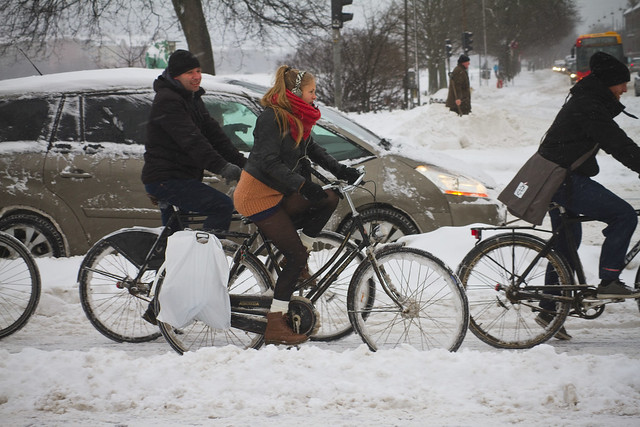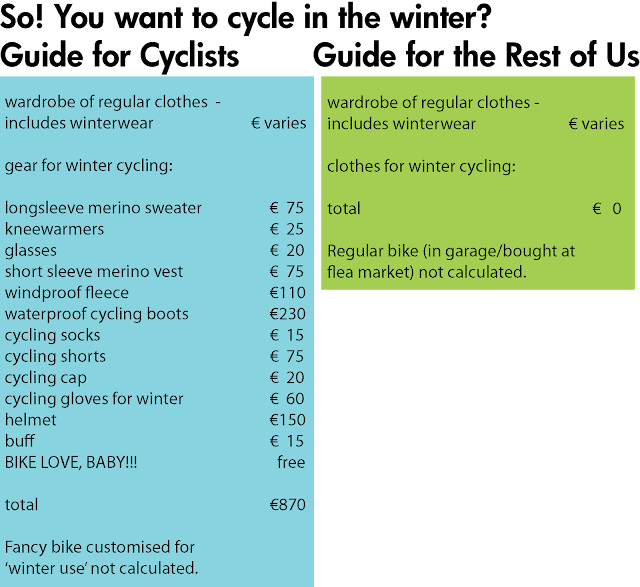Overcomplicating Winter Cycling - Why It's Bad

One of the main focuses of this blog has always been on how Copenhagen and other cities have succeeded in increasing cycling levels by approaching the subject using mainstream marketing techniques. Tried and tested marketing that has existed since homo sapiens first started selling or trading stuff to each other.
Modern bicycle advocacy, by and large, is flawed. It is firmly inspired by environmentalism which, in turn, is the greatest marketing flop in the history of humankind. Four decades of sub-cultural finger-wagging, guilt trips and preaching have given few results among the general population.
When sub-cultural groups start trying to indoctrinate and convert the public, it rarely ever succeeds. For the better part of a century, people all over the planet rode bicycles because they were quick, easy, convenient and enjoyable. In hilly cities. In hot cities. In snowy cities.
After the bicycle largely disappeared from the urban landscape because urban planning started revolving around the car and the automobile industry began their dreadfully effective marketing after the Second World War, many regions in the world have been left suffering in a bicycle vacuum.
The result is that an entire generation has been given the impression that cycling is something that a few people do for sport or recreation and not much else. People who take their hobby seriously and who invest in all manner of clothes and gear.
Regular citizens are hardly inspired to join such groups.
Now we are in the midst of a veritable bicycle boom all over the world. It's exciting. It's challenging. We were excited by the cycling revival in the 1970's but, as we all know, that faded to black again. It is of utmost importance that we maintain our current momentum and (re)secure the bicycle's place in our cities.
This will only be achieved if we focus on marketing urban cycling as a normal activity for regular citizens. If we concentrate on the masses who could be cycling, would like to be cycling, might take up urban cycling. When sub-cultures are the most vocal advocates we see that most of the advocacy stems from their own passion for their hobby/lifestyle. It seems that the goal is to get more people to join their ranks and become 'one of them', as opposed to selling urban cycling as it was meant to be from the beginning of Bicycle Culture 1.0 in the late 19th century - individual mobility for Citizen Cyclists.
So. It's that time of year again. All manner of 'how to cycle in the winter' guides are slapped up all over the internet. Year after year the sub-cultures put on their professor hats and look down their nose at the general population while they attempt to 'teach' people how to be just like them. You know...
real cyclists.
I have stumbled upon
a blogpost with an infographic like this one and a couple of months ago
this article featured in a magazine that used to be focused on Citizen Cyclists but that has gone all sub-cultural. (they even name brand names in their 'guide', reflecting the fact that they are dependent on sponsors and advertising and not subscriptions)
While
I blogged about this strange phenomenon way back in 2008 after blogging about
yet another sub-cultural winter clothing guide on this website, I got curious.
Let's assume a regular citizen wanted to ride a bike in the winter. What if they stumbled upon one of the links with the infographic or guide I just mentioned?
What would this citizen - who, like the majority of the population, doesn't want to be a member of a club or sub-culture - think about what they read?
Dressing in layers? Sure. But you know what? People who live in winter climates know that already, for god's sake. They do it when they walk around the city, taking the bus or train or whatever. So they can probably figure it out when on a bicycle. And, after one day doing so, if they discover they got cold, they'll put extra clothes on the next day.
I own no cycling 'gear' whatsoever. I have, however, a winter wardrobe as I live in a country with a winter climate and I ski, etc.
What would it cost me - Joe Bicycle User - if I followed the 'advice' on these websites? Using the infographic on that website as a guide, I did some quick googling to find out some prices. I didn't spend an enormous amount of time on it, I must admit. So some of the items may be cheaper - or they might be more expensive because I didn't discover 'the coolest brands'.

As you can see, if I don't calculate my bike, I would be easily €870 ($1100) out of pocket in order to be 'just like them'. Sure, maybe there are many people who wish to take their hobby seriously and acquire all that gear, but let's face it. Most people don't. They're just pondering riding their bike in the winter because they've gotten hooked riding it all year.
But it's this kind of sub-cultural crap that the curious, potential winter bicycle users end up with after a google search.
Google "winter cycling clothes" yourself and see what comes up. The results are dominated by 'cyclists' keen on recruiting, with little advice aimed at regular citizens. Not a good sign if we are trying to get people to rediscover the simplicity and convenience of urban cycling that people have enjoyed for over a century. [...continues...]







